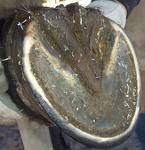A horse is only as sound as her bare feet. Care and management of the barefoot hoof will vary, however, depending on the individual horse, her conformation and hoof structure, environment, climate and use. Whether she needs to be shod or can be left barefoot will also hinge on these factors.
Trimming and Cleaning 
Julie Bullock, DVM, an equine practitioner who primarily treats horse hoof problems in Mt. Sidney, VA, says horse owners should try to keep a barefoot horse’s feet tidy with no rough edges to split or chip. “They can do this themselves by rasping away superficial cracks and keeping the edges smooth,” she says. “Cracks and flares give infection an opening to enter the bare foot. I see a lot of white line disease in our area due to lack of foot care.”
Periodically rasping around the edges (barefoot trimming) can prevent or eliminate cracks and flares, but you should leave the sole alone because it needs a thick callous. Leave the barefoot horse’s foot with a slightly longer hoof wall than a foot you’d put a shoe on, but keep it very smooth–rasping whenever it becomes ragged.
As a veterinarian and horse owner, Bullock does not recommend cleaning out the feet on regular basis. “The bars, frog, and sulcus of the frog are designed to allow dirt to pack in, creating a natural hoof pad,” explains Bullock.
Tia Nelson, DVM, who is a private practitioner as well as a farrier in Helena, Mont., says the mud and dirt that packs into the feet helps as part of the foot support to protect and cushion the foot. A horse at pasture shouldn’t need the feet cleaned. “You should periodically take a look at the feet, however, to make sure there are no cracks or problems,” says Nelson.
“The material that packs into the foot will fly out on its own when the horse “exercises,” says Bullock. “I try to look at how Mother Nature designed the foot.”
 Wild horses travel on more abrasive terrain which keeps their bare feet trimmed and smooth – their own natural hoof trimming – and travel many miles per day as they graze and go to water. No one ever cleans out their feet or trims them.
Wild horses travel on more abrasive terrain which keeps their bare feet trimmed and smooth – their own natural hoof trimming – and travel many miles per day as they graze and go to water. No one ever cleans out their feet or trims them.
“This doesn’t mean they can’t get cracks or flares, but they tend to keep a very tidy foot,” says Bullock. “It’s amazing what happens to a mustang from out West when it comes to the East Coast. We have more humidity and don’t have the abrasive footing, and their feet deteriorate badly.”
It’s important to note that whether or not your horses’ barefoot hooves require regular cleaning depends on where/how she’s housed.
Click here for the rest of the article, found at thehorse.com.
Chris Freeman

Accounts Manager
I am responsible for the accounting at EasyCare. My responsibilities require me to manage accounts payable, accounts receivable, purchasing, receipt of inventory and international order processing.




